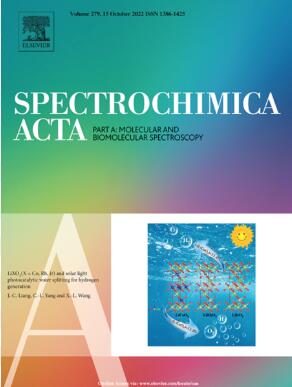Selective detection of streptomycin using a molecularly imprinted fluorescence sensor based on mangosteen peel-derived nitrogen-doped carbon quantum dots
IF 4.3
2区 化学
Q1 SPECTROSCOPY
Spectrochimica Acta Part A: Molecular and Biomolecular Spectroscopy
Pub Date : 2025-06-30
DOI:10.1016/j.saa.2025.126622
引用次数: 0
Abstract
Streptomycin, a broad-spectrum aminoglycoside antibiotic, is widely used in both human and veterinary medicine. Its overuse and environmental accumulation pose serious health risks, underscoring the need for sensitive and selective detection methods. In this study, we developed a molecularly imprinted fluorescence sensor (MIP-FS) by integrating nitrogen-doped carbon quantum dots (N-CQDs) with molecularly imprinted polymers (MIPs) for the selective detection of streptomycin. The N-CQDs were synthesized via a green microwave-assisted method using mangosteen peel as a sustainable and low-cost carbon source, representing an alternative biomass-based route for nanomaterial production. The resulting N-CQDs@MIPs displayed excellent fluorescence properties, high photostability, and strong selectivity for streptomycin through a fluorescence enhancement mechanism. Under optimized conditions, the sensor achieved a low detection limit of 3.2 nM (1.8 ppb) and a wide linear range from 0.01 to 8.00 μM. It also exhibited high selectivity against structurally similar antibiotics and common interfering ions. The method was successfully applied to pharmaceutical and environmental water samples, yielding results consistent with LC-MS/MS. These findings highlight the potential of the developed sensor as a rapid, sensitive, and eco-friendly tool for streptomycin detection in complex matrices.

基于山竹皮衍生的氮掺杂碳量子点的分子印迹荧光传感器选择性检测链霉素
链霉素是一种广谱氨基糖苷类抗生素,广泛应用于人兽医学。它的过度使用和环境积累构成严重的健康风险,强调需要敏感和有选择性的检测方法。在这项研究中,我们通过将氮掺杂碳量子点(N-CQDs)与分子印迹聚合物(MIPs)集成,开发了一种分子印迹荧光传感器(MIP-FS),用于选择性检测链霉素。利用山竹皮作为可持续的低成本碳源,通过绿色微波辅助方法合成了N-CQDs,代表了基于生物质的纳米材料生产的替代途径。所得N-CQDs@MIPs通过荧光增强机制对链霉素表现出优异的荧光特性、高的光稳定性和较强的选择性。在优化条件下,该传感器的检测限低至3.2 nM (1.8 ppb),线性范围为0.01 ~ 8.00 μM。对结构相似的抗生素和常见的干扰离子也表现出较高的选择性。该方法成功地应用于制药和环境水样,所得结果与LC-MS/MS一致。这些发现突出了该传感器作为复杂基质中链霉素检测的快速、敏感和环保工具的潜力。
本文章由计算机程序翻译,如有差异,请以英文原文为准。
求助全文
约1分钟内获得全文
求助全文
来源期刊
CiteScore
8.40
自引率
11.40%
发文量
1364
审稿时长
40 days
期刊介绍:
Spectrochimica Acta, Part A: Molecular and Biomolecular Spectroscopy (SAA) is an interdisciplinary journal which spans from basic to applied aspects of optical spectroscopy in chemistry, medicine, biology, and materials science.
The journal publishes original scientific papers that feature high-quality spectroscopic data and analysis. From the broad range of optical spectroscopies, the emphasis is on electronic, vibrational or rotational spectra of molecules, rather than on spectroscopy based on magnetic moments.
Criteria for publication in SAA are novelty, uniqueness, and outstanding quality. Routine applications of spectroscopic techniques and computational methods are not appropriate.
Topics of particular interest of Spectrochimica Acta Part A include, but are not limited to:
Spectroscopy and dynamics of bioanalytical, biomedical, environmental, and atmospheric sciences,
Novel experimental techniques or instrumentation for molecular spectroscopy,
Novel theoretical and computational methods,
Novel applications in photochemistry and photobiology,
Novel interpretational approaches as well as advances in data analysis based on electronic or vibrational spectroscopy.

 求助内容:
求助内容: 应助结果提醒方式:
应助结果提醒方式:


